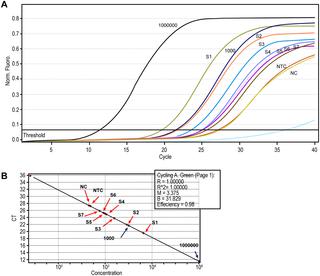当前位置:
X-MOL 学术
›
PLOS Negl. Trop. Dis.
›
论文详情
Our official English website, www.x-mol.net, welcomes your
feedback! (Note: you will need to create a separate account there.)
Molecular detection and identification of Leishmania DNA and blood meal analysis in Phlebotomus (Larroussius) species.
PLOS Neglected Tropical Diseases ( IF 3.4 ) Pub Date : 2020-03-26 , DOI: 10.1371/journal.pntd.0008077 Latifa Remadi 1 , Najla Chargui 1 , Maribel Jiménez 2 , Ricardo Molina 2 , Najoua Haouas 1, 3 , Estela González 2 , Raja Chaabane-Banaouas 1 , Eya Ben Salah 1 , Mohsen Haddaji 4 , Yassine Chaabouni 5 , Hamouda Babba 1
PLOS Neglected Tropical Diseases ( IF 3.4 ) Pub Date : 2020-03-26 , DOI: 10.1371/journal.pntd.0008077 Latifa Remadi 1 , Najla Chargui 1 , Maribel Jiménez 2 , Ricardo Molina 2 , Najoua Haouas 1, 3 , Estela González 2 , Raja Chaabane-Banaouas 1 , Eya Ben Salah 1 , Mohsen Haddaji 4 , Yassine Chaabouni 5 , Hamouda Babba 1
Affiliation

|
BACKGROUND
Phlebotomus (Larroussius) perniciosus and Canis familiaris are respectively the only confirmed vector and reservoir for the transmission of Leishmania (L.) infantum MON-1 in Tunisia. However, the vector and reservoir hosts of the two other zymodemes, MON-24 and MON-80, are still unknown. The aim of this study was to analyze the L. infantum life cycle in a Tunisian leishmaniasis focus. For this purpose, we have focused on: i) the detection, quantification and identification of Leishmania among this sand fly population, and ii) the analysis of the blood meal preferences of Larroussius (Lar.) subgenus sand flies to identify the potential reservoirs.
METHODOLOGY AND FINDINGS
A total of 3,831 sand flies were collected in seven locations from the center of Tunisia affected by human visceral leishmaniasis. The collected sand flies belonged to two genus Phlebotomus (Ph.) (five species) and Sergentomyia (four species). From the collected 1,029 Lar. subgenus female sand flies, 8.26% was positive to Leishmania by ITS1 nested PCR. Three Leishmania spp. were identified: L. infantum 28% (24/85), L. killicki 13% (11/85), and L. major 22% (19/85). To identify the blood meal sources in Ph. Lar. subgenus sand flies, engorged females were analyzed by PCR-sequencing targeting the vertebrate cytochrome b gene. Among the 177 analyzed blood-fed females, 169 samples were positive. Sequencing results showed seven blood sources: cattle, human, sheep, chicken, goat, donkey, and turkey. In addition, mixed blood meals were detected in twelve cases. Leishmania DNA was found in 21 engorged females, with a wide range of blood meal sources: cattle, chicken, goat, chicken/cattle, chicken/sheep, chicken/turkey and human/cattle. The parasite load was quantified in fed and unfed infected sand flies using a real time PCR targeting kinetoplast DNA. The average parasite load was 1,174 parasites/reaction and 90 parasites/reaction in unfed and fed flies, respectively.
CONCLUSION
Our results support the role of Ph. longicuspis, Ph. perfiliewi, and Ph. perniciosus in L. infantum transmission. Furthermore, these species could be involved in L. major and L. killicki life cycles. The combination of the parasite detection and the blood meal analysis in this study highlights the incrimination of the identified vertebrate in Leishmania transmission. In addition, we quantify for the first time the parasite load in naturally infected sand flies caught in Tunisia. These findings are relevant for a better understanding of L. infantum transmission cycle in the country. Further investigations and control measures are needed to manage L. infantum transmission and its spreading.
中文翻译:

博勒莫氏菌属物种的利什曼原虫DNA分子检测和鉴定以及血粉分析。
背景技术腓肠杆菌(Larroussius)perniciosus和Canisaffantis分别是在突尼斯传播婴儿利什曼原虫(L.)婴儿MON-1的唯一证实载体和贮藏库。但是,仍然未知两个其他酶模式的载体和宿主宿主MON-24和MON-80。这项研究的目的是分析突尼斯利什曼病的婴儿生命周期。为此,我们着重于:i)在该沙蝇种群中检测,定量和鉴定利什曼原虫,以及ii)对Larroussius(Lar。)亚属沙蝇的血粉偏好进行分析,以确定潜在的储层。方法学和发现在突尼斯中心受人内脏利什曼病影响的七个地方,共收集了3,831只苍蝇。收集到的沙蝇属于两个物种:Phlebotomus(Ph。)(五个物种)和Sergentomyia(四个物种)。从收集的1,029 Lar。ITS1巢式PCR检测到,亚属雌性沙蝇对利什曼原虫呈阳性,为8.26%。三个利什曼原虫属。确定为:婴儿乳杆菌28%(24/85),杀伤性乳杆菌13%(11/85)和大乳杆菌22%(19/85)。为了确定拉尔博士的血粉来源。沙蝇亚属,充血的雌性通过针对脊椎动物细胞色素b基因的PCR测序进行了分析。在分析的177名经血喂养的女性中,有169个样本呈阳性。测序结果显示了七个血液来源:牛,人,绵羊,鸡,山羊,驴和火鸡。另外,在十二例中发现混合血粉。在21名饱足的女性中发现了利什曼原虫DNA,其血粉来源广泛:牛,鸡,山羊,鸡/牛,鸡/绵羊,鸡/火鸡和人/牛。使用靶向动植物体DNA的实时PCR定量进食和未进食受感染沙蝇中的寄生虫负荷。未喂食和喂食的果蝇的平均寄生虫负荷分别为1,174个寄生虫/反应和90个寄生虫/反应。结论我们的研究结果支持了长柄假单胞菌,perfiliewi假单胞菌和perniciosus假单胞菌在婴儿乳杆菌传播中的作用。此外,这些物种可能参与了大乳酸杆菌和killicki的生命周期。在这项研究中,寄生虫检测和血粉分析的结合突出了在利什曼原虫传播中鉴定出的脊椎动物的犯罪行为。此外,我们首次量化了突尼斯捕获的自然感染沙蝇中的寄生虫负荷。这些发现与更好地了解L有关。该国的婴儿传播周期。需要进一步的调查和控制措施来管理婴儿乳杆菌的传播及其传播。
更新日期:2020-03-27
中文翻译:

博勒莫氏菌属物种的利什曼原虫DNA分子检测和鉴定以及血粉分析。
背景技术腓肠杆菌(Larroussius)perniciosus和Canisaffantis分别是在突尼斯传播婴儿利什曼原虫(L.)婴儿MON-1的唯一证实载体和贮藏库。但是,仍然未知两个其他酶模式的载体和宿主宿主MON-24和MON-80。这项研究的目的是分析突尼斯利什曼病的婴儿生命周期。为此,我们着重于:i)在该沙蝇种群中检测,定量和鉴定利什曼原虫,以及ii)对Larroussius(Lar。)亚属沙蝇的血粉偏好进行分析,以确定潜在的储层。方法学和发现在突尼斯中心受人内脏利什曼病影响的七个地方,共收集了3,831只苍蝇。收集到的沙蝇属于两个物种:Phlebotomus(Ph。)(五个物种)和Sergentomyia(四个物种)。从收集的1,029 Lar。ITS1巢式PCR检测到,亚属雌性沙蝇对利什曼原虫呈阳性,为8.26%。三个利什曼原虫属。确定为:婴儿乳杆菌28%(24/85),杀伤性乳杆菌13%(11/85)和大乳杆菌22%(19/85)。为了确定拉尔博士的血粉来源。沙蝇亚属,充血的雌性通过针对脊椎动物细胞色素b基因的PCR测序进行了分析。在分析的177名经血喂养的女性中,有169个样本呈阳性。测序结果显示了七个血液来源:牛,人,绵羊,鸡,山羊,驴和火鸡。另外,在十二例中发现混合血粉。在21名饱足的女性中发现了利什曼原虫DNA,其血粉来源广泛:牛,鸡,山羊,鸡/牛,鸡/绵羊,鸡/火鸡和人/牛。使用靶向动植物体DNA的实时PCR定量进食和未进食受感染沙蝇中的寄生虫负荷。未喂食和喂食的果蝇的平均寄生虫负荷分别为1,174个寄生虫/反应和90个寄生虫/反应。结论我们的研究结果支持了长柄假单胞菌,perfiliewi假单胞菌和perniciosus假单胞菌在婴儿乳杆菌传播中的作用。此外,这些物种可能参与了大乳酸杆菌和killicki的生命周期。在这项研究中,寄生虫检测和血粉分析的结合突出了在利什曼原虫传播中鉴定出的脊椎动物的犯罪行为。此外,我们首次量化了突尼斯捕获的自然感染沙蝇中的寄生虫负荷。这些发现与更好地了解L有关。该国的婴儿传播周期。需要进一步的调查和控制措施来管理婴儿乳杆菌的传播及其传播。











































 京公网安备 11010802027423号
京公网安备 11010802027423号